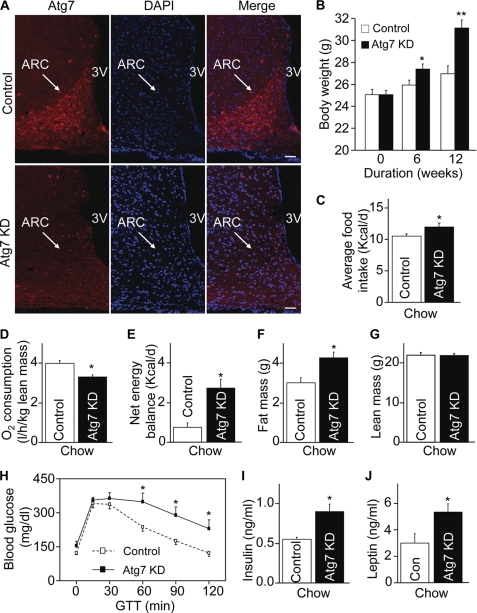FIGURE 4.
Metabolic phenotype of mice with MBH-specific Atg7 knockdown on chow feeding. C57BL/6 mice (chow-fed adult males) with Atg7 knockdown (Atg7 KD) versus the control were generated using bilateral injections of the MBH with lentiviruses containing shRNA against mouse Atg7 or the matched control shRNA. A, Atg7 immunostaining (red) of brain sections was performed to verify Atg7 knockdown in the MBH. DAPI staining (blue) reveals the nuclei of all cells in the sections. Scale bar = 50 μm. KD, knockdown. B and C, longitudinal follow-up of body weight (B) and average daily food intake (C) of chow-fed mice over 12 weeks post-MBH injection. *, p < 0.05; **, p < 0.01 (comparisons between two mouse groups at the matched time points that are underlined); n = 12–13 per group. Data are presented as mean ± S.E. D, metabolic chamber assessment of O2 consumption was performed for a subgroup of chow-fed mice at week 5 post injection. O2 consumption was corrected by lean body mass of mice. *, p < 0.05; n = 4 per group. Data are presented as mean ± S.E. E, net energy balance was calculated by subtracting energy expenditure ((3.815 + 1.232 × VCO2/VO2) × VO2, Columbus Instruments) from energy intake for mice at week 5 post-injection. *, p < 0.05; n = 4 per group. Data are presented as mean ± S.E. F and G, MRI assessment of fat mass (D) and lean mass (E) was performed for a subgroup of chow-fed mice at 5 weeks post-injection. *, p < 0.05; n = 6–8 per group. Data are shown as mean ± S.E. H–J, a subgroup of chow-fed mice was analyzed for glucose tolerance (H), fasting blood insulin concentration (I), and fasting blood leptin concentration (J) at week 10 post-injection. *, p < 0.05; n = 6 per group. Data are shown as mean ± S.E. GTT, glucose tolerance test; Con, control.

